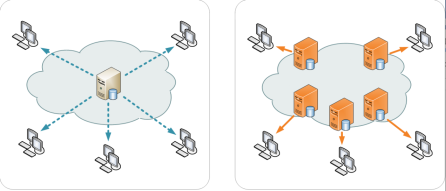 By Sebastian Stock
By Sebastian Stock
In Akamai Technologies, Inc. v. Limelight Networks, the Federal Circuit broadened potential patent infringement claims by no longer requiring a defendant perform all the steps of a patented method before direct infringement occurs. As the dust settles from Akamai, should courts expect an influx of patent infringement suits.
Akamai Technologies, Inc. began in 2006 when Akamai Technologies, Inc. (“Akamai”) sued Limelight Networks, Inc. (“Limelight”), claiming infringement of claims on its patent related to its content delivery network (“CDN”). A CDN is a platform of proxy servers designed to directly deliver end-user internet content. CDN’s are widely used – they carry nearly half of the world’s internet traffic.
Akamai alleged that Limelight’s CDN performed each step of Akamai’s US Patent 6,108,703 method with one exception – an additional “tagging” step that Limelight required customers to perform. The case went to a jury, which found Limelight liable for infringement and awarded Akamai $45.5 million in damages. Akamai’s victory, however, was short-lived. Nearly a decade of appeals and remands eventually vaulted the case to the U.S. Supreme Court in 2014. The Court’s final opinion, however, remained limited to an analysis of induced infringement under § 271(b), which states that an actor is liable for infringement if it actively induces infringement of a patent. Ruling in Limelight’s favor, the Court held that if a defendant did not perform all the steps of a patented method, it could not be held liable for inducing infringement. While noting the inducement issue in Limelight’s case necessitated remand, Justice Alito, writing for a unanimous Court, more than subtly hinted to the Federal Circuit that it was free to revisit its analysis of direct infringement under § 271(a). And that is just what it did.
Traditionally, direct infringement liability required a single party to perform every step of a claimed method. However, with a new focus, and after issuing a per curiam order granting en banc review, the Federal Circuit expanded the circumstances under which alleged infringers may be liable for direct infringement. Reaffirming its own precedent, the court concluded that direct infringement occurs when all the steps of a claimed method are performed or attributable to a single entity. From this, the court further explained that liability can be attributable to a single entity when more than one actor was involved in performing the steps of a method claim in two circumstances: (1) where that entity directs or controls others’ performance, and (2) where the actors form a joint enterprise.
Accordingly, an entity directs or controls another when it conditions participation or receipt of a benefit upon performance of a step or steps of a patented method, and establishes the manner and timing of such performance. Further, two or more actors can each be held liable for the actions of the others when they form a joint enterprise under tort theory.
Whether actors entered into a joint enterprise as well as the issue of direction or control are questions of fact for the jury, under proper direction from the court.
In so finding, the Federal Circuit waved farewell to precedent that had limited direct infringement to principal-agent relationships, contractual arrangements, and joint enterprise. Furthermore, the court reinstated the jury verdict, ruling that Limelight had directed or controlled its customers’ performance by conditioning use of its CDN on fulfilment of the last step of Akamai’s claimed method; if customers did not follow the precise “tagging” step, Limelight’s service would not be available to them.
Akamai Technologies, Inc. not only lowers the bar for patent licensees to sue potential infringers in the future, it also reengages the spasmodic ferris wheel of related patent suits being decided concurrently. Direct infringement cases like Travel Sentry v. Tropp that were stayed while Akamai was appealed are now being decided in light of the decision. Courts must reconsider cases in which multiple actors were involved in performing all the steps of a claimed method. Cases that would have been previously decided by motions for summary judgment now have the potential of making it to a jury. The subjects that constitute direct infringement will surely expand. Although the District Court for the Eastern District of New York found no direct infringement in Travel Sentry, an appeal was filed on October 7, 2016, foreshadowing the Federal Circuit’s imminent review and refinement of its new direct infringement standard.
Direct infringement is not the only law that could see change, however.
The Supreme Court’s ruling in Akamai simply reiterates that a defendant could only be liable for inducing infringement if it had directly infringed on the patent. Previously, this meant performing all the steps of the claimed method. Now the bar is lower. With the expansion of direct infringement, courts will surely see an inflow of induced infringement claims as well.
Image Source: Wikipedia